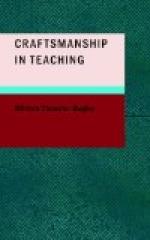Other similar cases could be cited, but I have probably said enough to make my point, and my point is this: that crude experience is an unsafe guide for practice; that experience may be refined in two ways—first by the slow, halting, wasteful operation of time, which has established many principles upon a pinnacle of security from which they will never be shaken, but which has also accomplished this result at the cost of innumerable mistakes, blunders, errors, futile efforts, and heartbreaking failures; or secondly, by the application of the principles of control and test which are now at our service, and which permit present-day teachers to concentrate within a single generation the growth and development and progress that the empirical method of trial and error could not encompass in a millennium.
The teaching of English merits treatment by this method. I recommend strongly that you give the plan a trial. You may not get immediate results. You may not get valuable results. But in any case, if you carefully respect the scientific proprieties, your experience will be worth vastly more than ten times the amount of crude experience; and, whether you get results or not, you will undergo a valuable discipline from which may emerge the ideals of science if you are not already imbued with them. I always tell my students that, even in the study of science itself, it is the ideals of science,—the ideals of patient, thoughtful work, the ideals of open-mindedness and caution in reaching conclusions, the ideals of unprejudiced observation from which selfishness and personal desire are eliminated,—it is these ideals that are vastly more important than the facts of science as such,—and these latter are significant enough to have made possible our present progress and our present amenities of life.
FOOTNOTES:
[Footnote 16: A paper read before the English Section of the University of Illinois High School Conference, November 17, 1910.]
XI
THE NEW ATTITUDE TOWARD DRILL[17]
Wandering about in a circle through a thick forest is perhaps an overdrawn analogy to our activity in attempting to construct educational theories; and yet there is a resemblance. We push out hopefully—and often boastfully—into the unknown wilderness, absolutely certain that we are pioneering a trail that will later become the royal highway to learning. We struggle on, ruthlessly using the hatchet and the ax to clear the road before us. And all too often we come back to our starting point, having unwittingly described a perfect circle, instead of the straight line that we had anticipated.
But I am not a pessimist, and I like to believe that, although our course frequently resembles a circle, it is much better to characterize it as a spiral, and that, although we do get back to a point that we recognize, it is not, after all, our old starting point; it is an homologous point on a higher plane. We have at least climbed a little, even if we have not traveled in a straight line.




